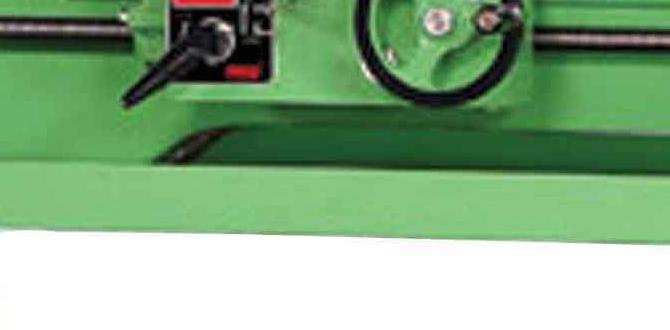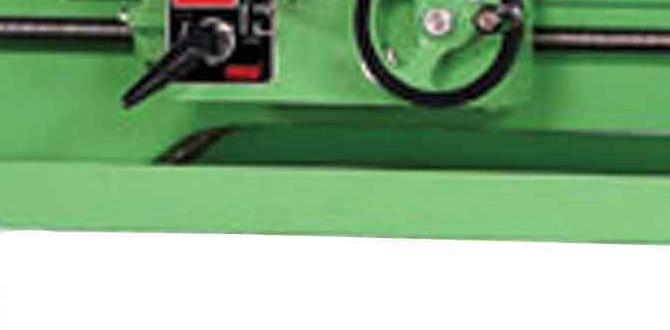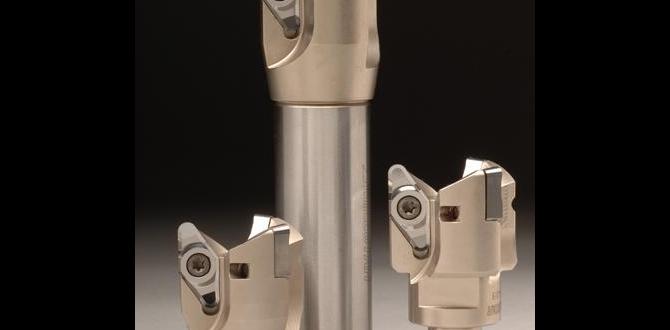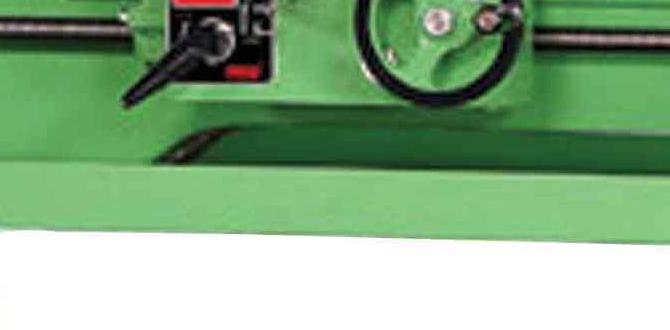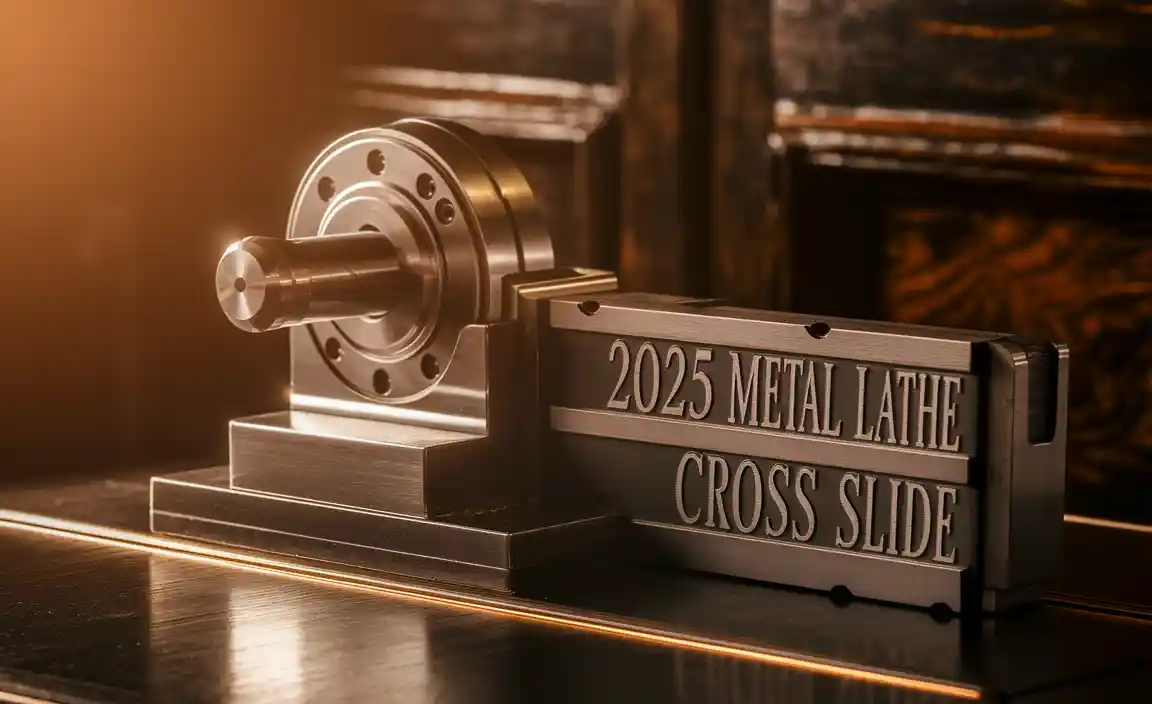Wood lathe tool steel types are crucial for your projects. Understanding the differences between High-Speed Steel (HSS), Carbon Steel, and Carbide will help you choose the right tools for cleaner cuts, longer sharpness, and a better woodworking experience.
Learning to turn wood on a lathe is an incredibly rewarding skill. It opens up a world of creating beautiful bowls, spindles, and more. But as you get started, you might notice different chisels and tools are made from different materials. This can be confusing! What’s the deal with all these “wood lathe tool steel types? Don’t worry, it’s simpler than it sounds. Choosing the right tool steel makes a huge difference in how your lathe spins, how smoothly your cuts are, and how long your tools stay sharp. This guide will walk you through the most common steel types you’ll encounter, so you can pick the perfect tools for your projects and achieve those amazing results you’re aiming for.
Why Wood Lathe Tool Steel Matters
At its core, understanding wood lathe tool steel types is all about getting the best performance and longevity from your tools. Think of it like this: your chisels are the instruments you use to sculpt wood. If your instruments aren’t right for the job, the music (or in this case, the turning) won’t sound as good.
Different woods have different densities and hardnesses. A tool made from a soft steel will dull very quickly when cutting a hard maple, leading to rough cuts and a lot of frustration. Conversely, using a tool that’s too brittle for a soft pine could lead to it chipping. The right steel will maintain a sharp edge for longer, allowing for cleaner cuts, less physical effort on your part, and ultimately, more enjoyable turning sessions. It also means you spend less time sharpening and more time creating.
The Main Players: Common Wood Lathe Tool Steels
When you’re shopping for wood lathe tools, you’ll most often see them made from one of these primary types of steel: High-Speed Steel (HSS), Carbon Steel, and Carbide. Each has its own strengths and weaknesses, making it a better fit for certain applications and user preferences.
1. High-Speed Steel (HSS)
High-Speed Steel is the undisputed champion for most woodturners, especially beginners. It’s called “high-speed” because it can withstand higher temperatures than older carbon steels without losing its hardness. This means you can cut at faster speeds, generating more friction and heat, but the tool edge will remain sharp.
Key Characteristics of HSS:
- Durability: HSS is tough and resistant to wear.
- Heat Resistance: It can handle the heat generated by fast turning without softening.
- Edge Retention: It holds a sharp edge for a good amount of time, though not as long as carbide.
- Sharpening: HSS is relatively easy to sharpen with common grinding wheels or honing stones.
- Cost: Generally more expensive than carbon steel but less than carbide.
Why HSS is Great for Beginners:
HSS offers a fantastic balance of performance, durability, and ease of use. It’s forgiving, meaning if you accidentally dig it in a bit too hard, it’s less likely to chip or break compared to some other materials. Its ability to hold an edge means you won’t find yourself needing to stop and sharpen every few minutes, allowing for a more productive and enjoyable learning experience.
When to Choose HSS:
HSS is the go-to for almost all woodturning tasks. Whether you’re roughing out a blank, turning spindle work, or shaping a bowl, HSS tools will perform admirably. They are excellent for both hard and soft woods.
2. Carbon Steel
Carbon steel was the traditional material for woodturning tools for a very long time. It’s essentially iron mixed with carbon. While it can achieve a very sharp edge, it has some notable downsides that have led to HSS becoming the standard.
Key Characteristics of Carbon Steel:
- Sharpness: Can be honed to an exceptionally sharp edge.
- Ease of Sharpening: Very easy to sharpen, often with simple sharpening mediums like sandpaper or fine grit stones.
- Lower Cost: Typically the least expensive option.
- Poor Heat Resistance: Will lose its hardness and dull quickly when subjected to heat from friction during turning.
- Prone to Rust: Carbon steel will rust if not meticulously cared for and kept dry.
Why Carbon Steel Might Be Less Ideal for Beginners:
The biggest drawback of carbon steel is its poor heat resistance. If you turn at anything but very slow speeds, the tool will heat up, and its edge will degrade rapidly. This means frequent stopping to re-sharpen, which can be very frustrating for someone just learning. Additionally, its susceptibility to rust requires diligent maintenance – cleaning and oiling after every use is essential to prevent corrosion.
When to Consider Carbon Steel:
Despite its drawbacks, carbon steel still has a place. If you are turning very slowly, working with very soft woods, or are on a very tight budget, carbon steel tools might be an option. Some traditional woodturners also prefer the feel and sharpening characteristics of carbon steel. However, for most modern woodturners looking for efficiency and ease, HSS is generally a better choice.
3. Carbide Inserts
Carbide tools are a more modern innovation in woodturning. Instead of a solid steel tool, these tools feature small, replaceable tips made of tungsten carbide. These tips are incredibly hard and can hold an edge for an exceptionally long time.
Key Characteristics of Carbide:
- Extreme Hardness: Tungsten carbide is significantly harder than HSS.
- Long-Lasting Edge: Can turn for very long periods before needing attention.
- Low Maintenance Edges: The inserts themselves are often not resharpened by the user but replaced when dull.
- Chip Resistance: Very resistant to chipping compared to HSS or carbon steel.
- Brittle: While hard, carbide can be brittle and may shatter if subjected to extreme shock or misuse.
- Sharpening Difficulty: Sharpening carbide inserts typically requires specialized diamond abrasives, which most beginners don’t have.
- Cost: Can be more expensive upfront, especially when considering replacement inserts.
Why Carbide is Popular (and its Caveats):
Carbide tools are incredibly popular because they require minimal sharpening (or rather, minimal user sharpening) and can last a very long time between needing attention. This means less downtime and consistent cutting performance. However, they can be less forgiving in terms of technique. If you accidentally ‘dig’ a carbide tool into the wood or catch it, the brittle insert can chip or break. Also, the way you use carbide tools is slightly different; they are often held at a specific angle and used with a scraping action rather than the traditional cutting action of HSS.
When to Choose Carbide:
Carbide tools are excellent for:
- Users who want minimal sharpening hassle.
- Turning harder woods where other steels might dull quickly.
- Achieving a very smooth finish, particularly on face grain bowls, with a simple sweep of the tool.
- Users who understand that the inserts are disposable and need eventual replacement.
Comparing the Steel Types: A Quick Look
To help you visualize the differences, here’s a table summarizing the key aspects:
| Feature | High-Speed Steel (HSS) | Carbon Steel | Carbide |
|---|---|---|---|
| Edge Retention | Good | Fair (dulls quickly with heat) | Excellent |
| Heat Resistance | Good | Poor | Excellent |
| Ease of Sharpening (by user) | Easy to Moderate | Very Easy | Difficult (requires special abrasives) |
| Durability (resistance to shock/chipping) | Good | Good | Fair to Good (can be brittle) |
| Cost (tool) | Moderate | Low | Moderate to High (initial) |
| Maintenance (rust) | Good (unless neglected) | Poor (requires diligent care) | Excellent (inserts are often coated) |
| Best For Beginners | Yes | No (generally) | Yes (with appropriate technique) |
Deep Dive: Understanding HSS Grades
Not all HSS is created equal! While “HSS” is often used as a blanket term, there are different grades, each with slightly varying compositions that affect performance. For woodturning, you’ll most commonly encounter these:
- M2 HSS: This is a very common and excellent all-around HSS for woodturning. It offers a good balance of hardness, toughness, and wear resistance. It’s what most beginner and intermediate tool sets are made from.
- M42 HSS: Often called “Cobalt HSS,” M42 has a higher percentage of cobalt mixed into the steel. This makes it even harder and more wear-resistant than M2. It holds an edge longer, especially in very abrasive hardwoods. However, it can be slightly harder to sharpen due to its increased hardness. Many profesionales favor M42 for its superior performance.
- CPM (Crucible Particle Metallurgy) Steels like CPM-M4 or CPM-S35VN: These are advanced powder metallurgy steels. They offer superior toughness and wear resistance, often outperforming traditional HSS grades. However, they are significantly more expensive and can be harder to sharpen. While fantastic, they are usually overkill for most beginner woodturners.
For a beginner, tools made from M2 HSS are an excellent starting point. They provide great performance without the added cost or sharpening challenges of more advanced grades. As you progress and your needs become more specific, you might explore tools made from M42 or other premium HSS alloys.
Tool Construction: Solid vs. Ferrule vs. Insert
Beyond the steel itself, how the tool is constructed also plays a role in its performance and durability.
- Solid Tools: These are the most traditional. The entire tool, from the cutting edge to the end of the handle (or a tang that fits into the handle), is made of the same steel. They offer a direct feel and can be resharpened right down to the tang.
- Ferrule Tools: Many HSS and carbon steel tools use a ferrule. This is a metal ring (often brass or steel) that connects the steel blade to the wooden handle. It prevents the handle from splitting from impact or glue. Ensure the ferrule is securely attached to the steel tang.
- Carbide Insert Tools: As mentioned, these have a handle and shank system with a small, replaceable carbide tip held in place by a screw. The design of the tool handle and the way the insert is mounted is crucial for rigidity and ease of use.
Choosing Your First Wood Lathe Tools
If you’re just starting out, the goal is to get a few versatile tools that will allow you to learn fundamental techniques. You don’t need a massive set.
Essential Tools for Beginners (Typically HSS):
- Gouge (Roughing Gouge or Spindle Gouge): This is your workhorse for shaping. A 1/2″ or 5/8″ roughing gouge is excellent for removing waste and establishing the basic shape of spindles or bowl blanks. A 3/8″ or 1/2″ spindle gouge is great for finer detail work on spindles.
- Scraper ( an Narex scraper or a skew chisel used as a scraper): While solid scrapers exist, many beginners find HSS skew chisels easier to control initially. They are useful for flattening tenons, smoothing shoulders, and creating beads.
- Parting Tool: Essential for cutting tenons for chuck mounting and for separating finished pieces from the waste block.
- Skew Chisel: This is a crucial tool for achieving smooth, paper-thin shavings, especially on spindle work. It has a steep learning curve but mastering it is incredibly rewarding. A 1/2″ or 5/8″ skew is a good starting point.
Where to Buy:
Reputable woodworking tool suppliers are your best bet. Brands like Robert Sorby, Hamlet, Crown, and Narex are known for producing quality HSS woodturning tools. For carbide, brands like Easy Wood Tools, Spes, and Carter Products offer popular systems. Always look for tools made from quality HSS (M2 or M42) or reputable carbide.
Sharpening Your Wood Lathe Tools
Knowing your steel type is only half the battle; keeping your tools sharp is essential.
HSS & Carbon Steel: These are typically sharpened using grinding wheels, diamond stones, or sharpening systems like the Wolverine system. The goal is to regrind the bevel at the correct angle and then hone the edge to razor sharpness. A common mistake is overheating HSS during grinding, which can ruin its temper. Using a slow-speed grinder or dipping the tool in water frequently can prevent this.
Carbide: As mentioned, these inserts usually don’t get “sharpened” by the user in the traditional sense. When they become dull, they are either rotated to a fresh edge (if there are multiple cutting edges) or replaced entirely. Some specialized diamond honing rods can be used for minor touch-ups if the insert has a specific sharpening geometry, but this is less common for beginners.
For detailed sharpening guides, resources like Woodturner Magazine and numerous YouTube channels dedicated to woodworking offer excellent visual tutorials on how to properly sharpen different types of woodturning tools.
Safety First: Always!
No matter what type of steel your tools are made from, safety is paramount when operating a wood lathe.
- Eye Protection: Always wear safety glasses or a full-face shield. Wood chips can fly at high speeds.
- Dust Mask: Turning wood creates fine dust. Protect your lungs.
- Tool Rest Placement: Ensure your tool rest is positioned correctly – close to the woodworking piece (about 1/8″ gap) and at the correct height for the tool you are using. This prevents the tool from being pulled into the spinning workpiece.
- Secure Workpiece: Make sure your wood blank is securely mounted in your chuck or between centers.
- Sharp Tools: Always use sharp tools. Dull tools require more force, are harder to control, and are more likely to cause accidents.
- Appropriate Apparel: Avoid loose clothing, jewelry, or anything that could get caught in the lathe.
Understanding the properties of your tool steel helps you use them safely and effectively. A sharp, properly made tool is inherently safer than a dull or damaged one.
Beyond the Basics: Specialty Steels and Coatings
While HSS, carbon steel, and carbide cover the vast majority of woodturning tools you’ll encounter, there are a few other considerations:
- Stellite: This is a cobalt-based alloy that is extremely hard and corrosion-resistant. It’s sometimes found in specialized scrapers or very high-end turning tools. It’s very difficult to sharpen and is usually found on tools designed for specific, demanding tasks.
- Coatings: You might see tools with various coatings (like titanium nitride or diamond-like carbon). These are usually applied to carbide inserts or specialized steel tools to further enhance hardness, reduce friction, or improve wear resistance. For beginner tools, these are generally not a primary concern but can be a feature on higher-end options.
For the beginner, focusing on understanding M2 or M42 HSS and basic carbide inserts is more than sufficient.
Frequently Asked Questions About Wood Lathe Tool Steel
Q1: Which wood lathe tool steel is best for a complete beginner?
For a complete beginner, High-Speed Steel (HSS) is generally the best choice. It offers a great balance of durability, ease of sharpening, and excellent edge retention, making it forgiving and efficient for learning fundamental techniques.
Q2: Are carbide woodturning tools better than HSS?
Carbide and HSS excel in different areas. Carbide has a harder, longer-lasting edge and requires less frequent sharpening (often by replacement), making it low-maintenance. HSS, while requiring more frequent sharpening, is tougher, less brittle, and generally easier for users to sharpen themselves. The “best” depends on your priorities: ease of maintenance (carbide) vs. user-sharpening flexibility and toughness (HSS).
Q3: What do I do if my HSS tools rust?
If your High-Speed Steel tools develop rust, you’ll need to remove it. Start with a fine-grit abrasive like 220-grit sandpaper or a Scotch-Brite pad. For heavier rust, you might need to use a rust remover specifically designed for tools or a bench grinder with a fine wheel, being careful not to overheat the steel. After removing the rust, clean the tool thoroughly and apply a light coat of tool oil or paste wax to prevent future corrosion.
Q4: How often do I need to sharpen HSS woodturning tools?
This depends heavily on the wood you’re turning, the type of cut you’re making, and the specific

